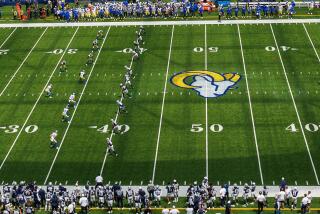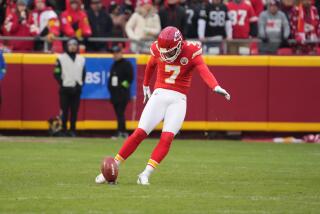NBA Goes Into Zone of Its Own
- Share via
Going where it had never gone before and never expected to, the NBA announced Thursday it will legalize zone defense--the latest attempt to revive offensive basketball, as well as attendance and television ratings.
The move, which required 20 votes, reportedly passed, 22-6 with one abstention, a league source said, with the Miami Heat, New York Knicks, Houston Rockets and Portland Trail Blazers among teams opposed.
The management of the Knicks and Rockets included several traditionalists such as Houston Coach Rudy Tomjanovich. The Heat has the East’s most dominating center, Alonzo Mourning, whose game might be hampered by zones.
However, the Lakers, who have the game’s most dominating center, Shaquille O’Neal, joined the majority in favor.
“As an organization, we did what we felt was in the best interests of the game,” Laker General Manager Mitch Kupchak said.
“Yeah, you could look at it and say maybe Shaquille will get three or four fewer touches, but maybe he’ll get one or two more blocks. Maybe Kobe [Bryant] will get fewer points but more assists.”
The package, which goes into effect next season, had four parts:
* Any defense will now be legal.
* No defender can stay in the lane longer than three seconds, unless he’s within six feet of the man he’s guarding. The league hopes this will keep seven-footers from guarding the basket.
* Teams will have eight seconds, not 10, to bring the ball over half-court. The league hopes this will encourage pressing defenses.
* Hand-checking is back. It isn’t clear what benefit the league thinks this will be, but it may reduce complaining about the referees, which has reached legendary proportions this season.
Despite the solid majority in favor, the package is highly controversial within league circles. Many coaches spoke out against it recently. Washington Wizard President Michael Jordan insisted that without the old rules keeping defenses from clogging the middle, it would have been harder to drive and “there would have been no Michael Jordan.”
Nevertheless, under the old rules, offense was disappearing before the league’s eyes, even as it tinkered with the rules, always in vain.
In 1985, when the Lakers finally broke through and beat the Celtics in the NBA finals, scoring peaked as teams averaged 110.8 points a game.
By 1994, the average was 101.5 and the league moved in the three-point line.
By 1997, it was 96.9 so the league moved the three-point line back.
By 1999, it was 91.6. Now the NBA was without Jordan and the Bulls’ dynasty and the league’s TV ratings were sagging as well. Two more years of minor adjustments, such as eliminating hand-checking, saw the average move back to 97 last season, but just as league executives were congratulating themselves, it fell to 94 this season as TV ratings cratered.
Now NBA executives concede ratings and attendance had everything to do with their resolve.
“Are we aware of TV ratings and attendance?” said Sun owner Jerry Colangelo, who chaired the committee that drafted the new rules. “Yes and yes.”
Having failed so many times to reverse the defensive tide, the package’s sponsors also acknowledge they don’t know if this will have the intended result or make things worse.
Said Deputy Commissioner Russ Granik, “Nobody can tell you exactly what will happen here.”
Said Colangelo: “It’s important to be willing to make the change, understanding you don’t know exactly how it’s going to turn out. But you’re willing to take that step. . . .
“I’m saying to you, [this is a] work in progress. This is something we’re going to continue to monitor. It may need another change or two or modification going forward.”
The current rules barring zone defenses were complex and little understood by anyone but referees, coaches and players.
However, their thrust was to make it easy to isolate a player on a single defender. This led to schemes that ate up the clock as teams threw the ball in, waited for the double-team, then threw the ball out, trying to find an open shooter before the defense could recover.
Fastbreaks all but disappeared because most teams “lifted” two or three players, stationing them above the three-point line, requiring their defenders to line up near them. This gave the offensive players a head start back the floor. Even when teams ran, defenses were always back.
The theory now is that coaches, loathe to play against sagging defenses in the half-court, will take more chances to run, opening up the game.
Of course, that will be debated until next November when the new rules debut.
ESPN’s resident expert, Jack Ramsay, who served on the Colangelo committee, supports the package, arguing: “Isolations make for an inactive and unattractive game that doesn’t involve all five players. Allowing zone defenses . . . will take away the standstill part of the game.
Unimpressed, another ESPN analyst, Fred Carter, says: “I think allowing the zone defense would kill the NBA game. They can’t even afford to take the gamble of putting in the zone.”
One thing is sure now: For better or worse, the NBA is taking the gamble.
(BEGIN TEXT OF INFOBOX / INFOGRAPHIC)
NBA Rules Changes
NBA owners voted Thursday on a set of rules changes that would allow zone defenses for the first time in league history. In any number of zone defenses, a team defends by making its players responsible for certain areas of the court rather than certain players on the opposing team. The rules will go into effect next season.
Defense
Players on the defensive team guard an area instead of an opponent. Together they can create a unit that makes it difficult to penetrate near the basket.
Offense
The offensive team usually attempts to break the zone by quickly passing the ball around the perimeter. If the defense does not shift quickly enough to keep up with the ball, a shooting lane opens up.
Other changes
* Eliminated current illegal defense guidelines.
* Established a defensive 3-second violation, prohibiting defenders from standing in the lane for more than 3 seconds.
* Reduced the time to advance the ball past midcourt from 10 seconds to 8 seconds.
* Reduced touch fouls caused by incidental contact.
(BEGIN TEXT OF INFOBOX / INFOGRAPHIC)
Rules Changes
* Eliminated all existing illegal defense guidelines.
* Established a defensive three-second rule, limiting how long a defensive player may stand in the lane when not closely guarding someone.
* Reduced from 10 seconds to eight seconds time for a team to advance the ball past midcourt
* Eliminated touch fouls by a defensive player if it does not impede the progress of the player with the ball.
More to Read
Go beyond the scoreboard
Get the latest on L.A.'s teams in the daily Sports Report newsletter.
You may occasionally receive promotional content from the Los Angeles Times.










